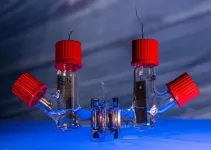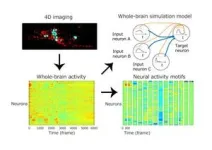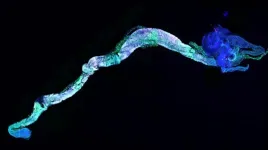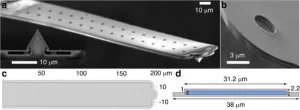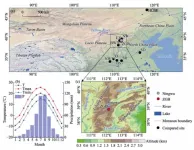(Press-News.org) by Jade Boyd
Special to Rice News
HOUSTON – (March 15, 2024) – Rice University synthetic biologists have found a way to piggyback on the glucose monitoring technology used in automated insulin dosing systems and make it universally applicable for the monitoring and dosing of virtually any drug.
In a recently published study in Nature Communications, researchers in the lab of Caroline Ajo-Franklin demonstrated the technique by modifying a blood-glucose sensor to detect the anticancer drug afimoxifene , an estrogen inhibitor that patient’s bodies also make after they take the chemotherapy tamoxifen.
By building on mature biosensing technology that’s commercially available at most drug stores for under $20, Ajo-Franklin’s team hopes to speed the development of automated dosing systems for chemotherapies and other drugs as well as other technologies for real-time monitoring of biomarkers in the blood.
“The dream is to have technology similar to what’s available today for monitoring and treating variations in blood glucose, and have that be true for basically any drug,” said Ajo-Franklin, a bioscientist, cancer researcher and director of the Rice Synthetic Biology Institute . “Millions of people use blood-glucose monitors every day. If we can use that same basic technology to monitor other drugs and biomarkers, we could move away from the one-size-fits-all dosing regimes that we’re stuck with today.”
The heart of blood-glucose monitoring technology is a biochemical reaction in which specific proteins bind to glucose molecules and release electrons. Millions of these reactions take place within seconds, creating a small electrical current that is proportional to the amount of glucose in the blood sample.
Rong Cai , a postdoctoral research associate and the lead author of the study, tested more than 400 slightly modified versions of the electron-releasing protein and found a version that reacted with afimoxifene, reducing the current output from the glucose reaction in the blood. This allowed the team to detect the presence of afimoxifene by comparing the current produced by the regular glucose test to the reduced current from the modified test.
To demonstrate the technology in an electronic device, Ajo-Franklin’s team worked with the research group of Rice engineer and materials scientist Rafael Verduzco to create an afimoxifene sensor that emitted a current when the drug was detected.
Ajo-Franklin said her lab is already working on both ways to improve the sensitivity of glucose-based drug tests and methods to rapidly identify glucose-oxidizing proteins that can detect drugs other than afimoxifene.
“The glucometer is the part that’s so well-developed,” Cai said. “While our target is different, it’s just a matter of engineering and changing the protein on the inside. On the outside, everything will still be the same. You can still do the test with a strip or on your arm.”
She said another key feature of the technology is that it produces an electrical output.
“If your signal is electrical, you can read it in your phone, store its data in your phone, send it to the cloud, whatever,” Cai said. “That’s the part, that marriage between electricity and biology, that is very attractive.”
Ajo-Franklin is a professor of biosciences in the Weiss School of Natural Sciences and a CPRIT Scholar in Cancer Research with the Cancer Prevention and Research Institute of Texas (CPRIT). Verduzco is a professor of chemical and biomolecular engineering and of materials science and nanoengineering in the George R. Brown School of Engineering .
The research was supported by CPRIT (RR190063), the National Science Foundation (1828869, 2223678) and the Army Research Office (W911NF-22-1-0239).
END
Rice breakthrough could make automated dosing systems universal
Synthetic biologists’ hack blood-glucose reaction to create chemotherapy detector
2024-03-15
ELSE PRESS RELEASES FROM THIS DATE:
UTA students earn transformative D.C. fellowships
2024-03-15
Seven undergraduate students from The University of Texas at Arlington headed to Washington, D.C., for a hands-on program to live, learn and intern in the nation’s capital.
Founded in 2001, The Archer Center is the Washington, D.C., campus of the University of Texas System. Students accepted to its Archer Fellowship Program move to the Capitol Hill area of Washington to live with other Archer Fellows and take courses taught by UT faculty and policy experts. The scholars also participate in a ...
Why some newborns develop severe infections
2024-03-15
NEW YORK, NY (March 15, 2024)--Compared to adults, newborns are highly susceptible to infections and these infections can cause serious health complications and even death.
One factor known to affect a newborn’s response to infection is a condition called neonatal neutropenia, in which the infant fails to make enough neutrophils, the immune system’s first responders. What underlies this immune deficiency, which greatly increases a newborn’s susceptibility to infection, is largely unknown, leaving clinicians with little understanding of how to prevent or treat it.
A new study of mice by Columbia University ...
Protein fragments ID two new “extremophile” microbes—and may help find alien life
2024-03-15
Perfectly adapted microorganisms live in extreme environments from deep-sea trenches to mountaintops. Learning more about how these extremophiles survive in hostile conditions could inform scientists about life on Earth and potential life on other planets. In ACS’ Journal of Proteome Research, researchers detail a method for more accurate extremophile identification based on protein fragments instead of genetic material. The study identified two new hardy bacteria from high-altitude lakes in Chile — an ...
Plasma oscillations propel breakthroughs in fusion energy
2024-03-15
Most people know about solids, liquids, and gases as the main three states of matter, but a fourth state of matter exists as well. Plasma—also known as ionized gas—is the most abundant, observable form of matter in our universe, found in the sun and other celestial bodies.
Creating the hot mix of freely moving electrons and ions that compose a plasma often requires extreme pressures or temperatures. In these extreme conditions, researchers continue to uncover the unexpected ways that plasma can move and evolve. By better understanding the motion of plasma, scientists gain valuable insights into solar physics, astrophysics, ...
Specialized nursing facility clinicians improve end-of-life care
2024-03-15
Specialized nursing facility clinicians, or SNFists, may decrease the likelihood of nursing home residents experiencing stressful hospitalizations and improve the quality of life in their last days, according to researchers from Weill Cornell Medicine.
The paper, published in JAMA Network Open on Mar. 15, examined how SNFists uniquely impacted the care of nursing home residents in their last 90 days, compared with those cared for by other clinicians. This large-scale study is the first of its kind.
“The literature has described ...
Fatty food before surgery may impair memory in old, young adults
2024-03-15
COLUMBUS, Ohio – Eating fatty food in the days leading up to surgery may prompt a heightened inflammatory response in the brain that interferes for weeks with memory-related cognitive function in older adults – and, new research in animals suggests, even in young adults.
The study, building upon previous research from the same lab at The Ohio State University, also showed that taking a DHA omega-3 fatty acid supplement for a month before the unhealthy eating and surgical procedure prevented the effects on memory linked to both the high-fat diet and the surgery in aged ...
Newly discovered receptor influences gut development in fruit flies
2024-03-15
Adhesion GPCRs belong to the large family of G protein-coupled receptors (GPCRs). There are about 700 variants in humans, which are responsible for sensory impressions, hormonal cycles, controlling the cardiovascular system and more. GPCRs translate stimuli that hit a cell from outside into an intracellular biochemical signal.
The use of the fruit fly as a model animal allows researchers in this field to gain a deep understanding of human diseases, because the animals are genetically very similar to humans. Scientists estimate that around 75 per cent of the genes involved in human diseases ...
New research suggests that our universe has no dark matter
2024-03-15
The current theoretical model for the composition of the universe is that it’s made of ‘normal matter,’ ‘dark energy’ and ‘dark matter.’ A new uOttawa study challenges this.
A University of Ottawa study published today challenges the current model of the universe by showing that, in fact, it has no room for dark matter.
In cosmology, the term “dark matter” describes all that appears not to interact with light or the electromagnetic field, or that can only be explained through gravitational force. We can’t see it, nor do we know what ...
A breakthrough in tiny tool tuning: making microscopic measurements more accurate
2024-03-15
A study introduces a novel method for calibrating the spring constant of FluidFM micropipette cantilevers, crucial for the accurate measurement of forces in microfluidic environments. This method addresses the limitations of current calibration techniques, offering a significant advancement in the field of force microscopy.
Fluidic force microscopy (FluidFM) combines the sensitivity of atomic force microscopy with microfluidics' capabilities, necessitating precise calibration of its cantilevers for reliable data. Traditional methods, however, struggle with the unique internal structure of FluidFM cantilevers, leading to ...
Unlocking the climate secrets of North China with ancient tree rings
2024-03-15
A recent study published in the Journal of Geographical Sciences in December 2023 reveals a novel method for reconstructing historical warm season temperatures in North China. Utilizing the blue intensity (BI) of tree rings of Picea meyeri, researchers have developed a 281-year chronology, offering unprecedented insights into the region’s climatic past.
The escalating public concern over climate warming, due to its significant impacts on society, ecosystems, and the environment, underscores the importance of understanding long-term climatic conditions across different regions. As the limited observational records constrain our comprehensive grasp of climate change, tree-ring data prove ...
LAST 30 PRESS RELEASES:
Low daily alcohol intake linked to 50% heightened mouth cancer risk in India
American Meteorological Society announces Rick Spinrad as 2026 President-Elect
Biomass-based carbon capture spotlighted in newly released global climate webinar recording
Illuminating invisible nano pollutants: advanced bioimaging tracks the full journey of emerging nanoscale contaminants in living systems
How does age affect recovery from spinal cord injury?
Novel AI tool offers prognosis for patients with head and neck cancer
Fathers’ microplastic exposure tied to their children’s metabolic problems
Research validates laboratory model for studying high-grade serous ovarian cancer
SIR 2026 delivers transformative breakthroughs in minimally invasive medicine to improve patient care
Stem Cell Reports most downloaded papers of 2025 highlight the breadth and impact of stem cell research
Oxford-led study estimates NHS spends around 3% of its primary and secondary care budget on the health impacts of heat and cold in England
A researcher’s long quest leads to a smart composite breakthrough
Urban wild bees act as “microbial sensors” of city health.
New study finds where you live affects recovery after a hip fracture
Forecasting the impact of fully automated vehicle adoption on US road traffic injuries
Alcohol-related hospitalizations from 2016 to 2022
Semaglutide and hospitalizations in patients with obesity and established cardiovascular disease
Researchers ‘listen in’ to embryo-mother interactions during implantation using a culture system replicating the womb lining
How changing your diet could help save the world
How to make AI truly scalable and reliable for real-time traffic assignment?
Beyond fragmented markets: A new framework for efficient and stable ride-pooling
Can shape priors make road perception more reliable for autonomous driving?
AI tracks nearly 100 years of aging research, revealing key trends and gaps
Innovative techniques enable Italy’s first imaging of individual trapped atoms
KIER successfully develops Korea-made “calibration thermoelectric module” for measuring thermoelectric device performance
Diversifying US Midwest farming for stability and resilience
Emphasizing immigrants’ deservingness shifts attitudes
Japanese eels, climate change, and river temperature
Pusan National University researchers discover faster, smarter heat treatment for lightweight magnesium metals
China’s 2024 Gastroenterology Report: marked progress in endoscopy quality and disease management
[Press-News.org] Rice breakthrough could make automated dosing systems universalSynthetic biologists’ hack blood-glucose reaction to create chemotherapy detector
